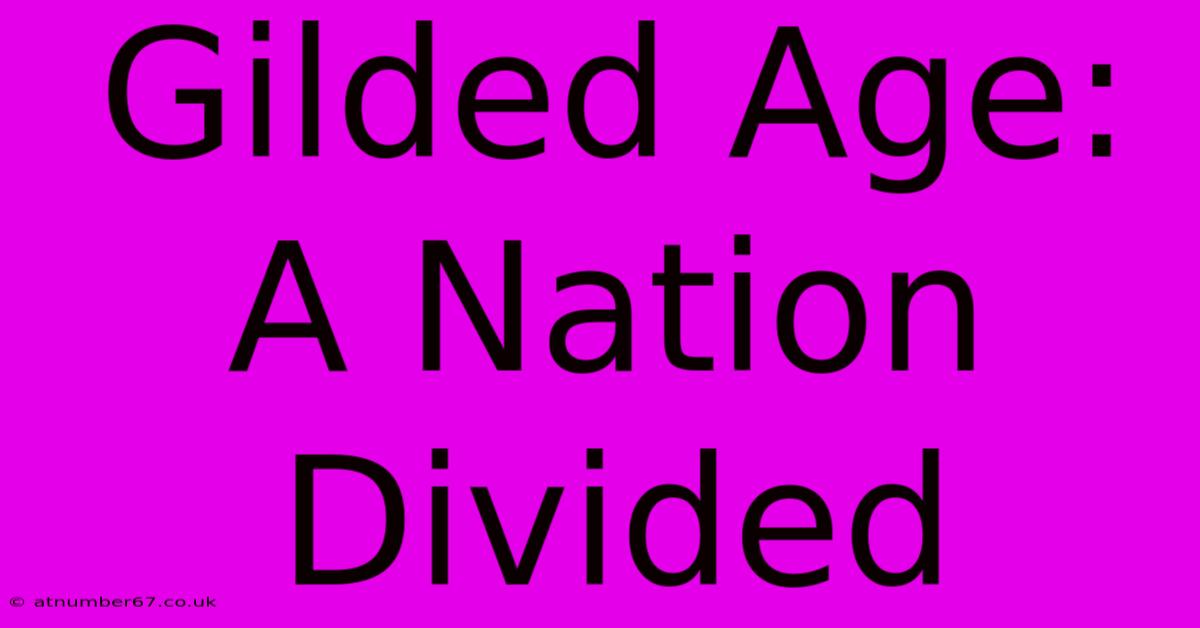Gilded Age: A Nation Divided

Table of Contents
Gilded Age: A Nation Divided – Opulence and Inequality in America
The Gilded Age. The very name conjures images of extravagant mansions, powerful industrialists, and rapid economic growth. But beneath the shimmering surface of prosperity lay a deep chasm of inequality, a stark division between the immensely wealthy and the struggling masses. This period, roughly spanning from the 1870s to the 1890s, was a time of significant transformation in American society, leaving an enduring legacy that continues to shape our understanding of wealth, power, and social justice.
The Rise of Industrial Titans and the Concentration of Wealth
The Gilded Age witnessed the rise of industrial giants like Andrew Carnegie (steel), John D. Rockefeller (oil), and J.P. Morgan (finance). These men, often dubbed "robber barons," amassed incredible fortunes through ruthless business practices, often exploiting workers and stifling competition. Their wealth was unprecedented, creating a stark contrast to the lives of the average American.
The Impact of Industrialization on the Working Class
While industrialization fueled economic growth, it also led to harsh working conditions for the majority. Long hours, low wages, and dangerous working environments were commonplace. Workers faced exploitation with little protection, leading to widespread poverty and social unrest. The lack of labor laws and the power wielded by industrialists created a system heavily weighted against the working class.
- Child labor: A particularly egregious issue was the widespread employment of children in factories and mines. These young workers were subjected to grueling conditions and denied their childhoods.
- Dangerous working conditions: Factory accidents were frequent and often resulted in severe injuries or death, with little to no compensation for the victims.
- Low wages and long hours: Workers were often forced to work extremely long hours for meager wages, leaving them barely able to afford basic necessities.
Political Corruption and the Limits of Democracy
The Gilded Age was also marked by significant political corruption. Powerful industrialists often wielded undue influence over government policies, using their wealth to secure favorable legislation and protect their interests. This created a system where the voices of the common people were often drowned out.
The Rise of Political Machines
Political machines, such as Tammany Hall in New York City, thrived on corruption, manipulating elections and enriching themselves through graft and patronage. These machines controlled local governments, often providing essential services to immigrant communities in exchange for votes, while simultaneously lining their pockets.
Social Reform Movements and the Fight for Equality
Despite the widespread inequality and corruption, the Gilded Age also witnessed the rise of powerful social reform movements. These movements fought for improved working conditions, women's suffrage, and racial equality.
The Progressive Movement
The Progressive Movement, gaining momentum at the turn of the 20th century, aimed to address the social and economic problems of the Gilded Age. Progressives advocated for reforms such as:
- Labor laws: Legislation to protect workers from exploitation, including shorter workdays, minimum wage laws, and improved working conditions.
- Trust-busting: Government action to break up monopolies and promote fair competition.
- Women's suffrage: The right for women to vote.
The Enduring Legacy of the Gilded Age
The Gilded Age left a profound and lasting impact on American society. The extreme wealth disparity, the rise of powerful corporations, and the struggles of the working class shaped the political and social landscape for decades to come. The legacy of this era continues to fuel debates about economic inequality, the role of government regulation, and the importance of social justice. Understanding this period is crucial for navigating the complexities of modern society.
Keywords: Gilded Age, Andrew Carnegie, John D. Rockefeller, J.P. Morgan, robber barons, industrialization, working class, poverty, child labor, political corruption, Tammany Hall, Progressive Movement, social reform, economic inequality, American history, 19th century America.

Thank you for visiting our website wich cover about Gilded Age: A Nation Divided. We hope the information provided has been useful to you. Feel free to contact us if you have any questions or need further assistance. See you next time and dont miss to bookmark.
Featured Posts
-
Is Junior Bridgemans Net Worth Overstated
Apr 05, 2025
-
Mbappes Son Will He Surpass His Fathers Achievements
Apr 05, 2025
-
Mac Sinise A Sons Legacy
Apr 05, 2025
-
Anna Chancellors Daughter A Life Of Passion
Apr 05, 2025
-
David Beckhams Daughters Pregnancy Yoga
Apr 05, 2025
